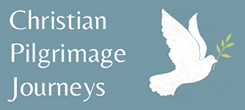
Visiting Mount Athos
As visitors approach a monastery in Mount Athos, the first thing they observe is that the buildings look like big castles, like fortified medieval citadels with an imposing and very tall wall, with towers now and then, with loop holes and hole for throwing hot (oil or water), as well as a huge dominating tower on the highest or the weakest spot of the monastery. The reason for these structures was the need of the monks to defend themselves against many and various enemies that tried to conquer and loot Mount Athos over the centuries (pirates, Franks, Catalans etc.).

In the middle of the wall there is only one entrance to the monastery with two gates close to each other. The gates are heavy wooden doors lined on the inside with long iron rods and on the outside covered with big metallic plates. Between the two gates there is a small cell where the visitors meet the Pyloros (Gatekeeper). His job is to lock the gates after sundown and open them at sunrise. He also checks the permits of the visitors and leads them to the Archontariki (entry hall).
There the visitors meet the Archontaris (Chief Host) who will offer them water, coffee, tsipouro (a Greek drink made from pressed grapes). Later, after signing the visitors’ book, the Archontaris helper will lead the visitors to their rooms to settle down. Usually rooms are two-, four-, up to ten-bed and the bathroom is located near, outside of the room. The small rooms would have a key, where the large would have their door permanently open. Most of the monasteries do not have mirrors in the bathroom, there is no hot water in some of the monasteries. The visitors are given clean sheets, blankets and plastic sleepers. Once everybody settled down the program of the monastery will be announced.
The most of the 20 monasteries of Holy Mount will keep the time Byzantine way. The day starts with sunrise. The usual day of the monastery is marked by constant prayer and service. With the sunset monks are going to their cells to rest a little and after to continue with their studies and prayer. They always hold komboskini (Eastern Orthodox prayer rope with 50 knots and 5 wooden beads).

The invention of the prayer rope is attributed to Saint Pachomius in the fourth century as an aid for illiterate monks to accomplish a consistent number of prayers and prostrations in their cells. Previously, monks would count their prayers by casting pebbles into a bowl, but this was cumbersome, and could not be easily carried about when outside the cell.
The use of the rope made it possible to pray the Jesus Prayer unceasingly, whether inside the cell or out, in accordance with Saint Paul's injunction to "Pray without ceasing". The monk, knot by knot, repeats the Jesus Prayer, the most important prayer of all orthodox ascetics.
The night prayer is called Kanonas and is the main weapon of a monk to fight any kind of human passion and desire and clear his way towards the goodness. More close to God and goodness it gets more and more difficult.
Around 2.00 in the morning, a monk crosses the yard of the monastery pounding the talanto (a wooden plank) with a wooden hammer. Later the simantro (wooden board), permanently hanged on a wall, will sound say way added by a sound of a metal simantro. The monks are called for the Holy Liturgy in the main church of the monastery, Katholikon. There they start with midnight prayer; the atmosphere is very solemn. The light is dim and black dressed figures of monks, more shadows then humans, enter quietly the church, pay their respect and take their places.

After the midnight prayer is time for Orthos, Ores (prayers) and Holy Liturgy. The psalms are performed by monks divided in two choirs. Lighted by candle light the priest will offer the Holy Communion to those repentant. He will offer after the completion of the Holy Liturgy to all attending adidoro (pieces of blessed monastery bread) and blessed water. Then everybody proceeds to the Trapeza (refectory) for the first meal of the day. Trapeza is usually decorated with beautiful iconography.
After the meal monks rest a little and go to their services. Everybody including Igoumenos (Abbot) has work to do. Young monks who are still on probation have heavier duties as a part of education on monastic life. Around 3.30 noon time, the talanto will sound again calling for Esperinos (evening prayer). Immediately after Esperinos all go to the Trapeza, because it is time to eat. The first to enter is the Igoumenos followed by the monks and the visitors who enter last.
The food is generally plain and frugal. Meat is not consumed. Meals consist of beams, vegetables, olives and fruits -occasionally, on feast days, fish- and their traditional bread. The wine which is always home - made is of the highest quality. In the middle of the long table and usually to its left there is pulpit from which the Reader reads, during the meal, extracts from the Bible and sermons.
After diner, a short Apodipno (compline) is said. It it time of the sunset, the doors of the monastery are closing and monks are going in their cells. The sleep in monastic life is limited, enough for the monk not to die or go crazy. Sleepiness for a monk is another way of demons to torture him and he is fighting it with constant prayers.


